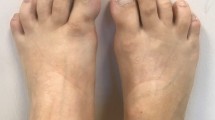Abstract
Fibrodysplasia ossificans progressiva (FOP) is an exceedingly rare genetic disorder of connective tissue characterized by extensive and irreversible heterotopic ossification of soft-tissue masses that develop in response to inflammation or trauma. Successful management relies on preventative measures and avoidance of invasive procedures such as intramuscular injections and biopsies. Early diagnosis can prevent extensive heterotopic ossification and is possible with recognition of the classic clinical findings in the feet in association with rapidly evolving soft-tissue masses of the trunk and extremities. Unfortunately, in 87% of the 269 previously reported cases, the diagnosis was not considered initially. Patients are often subjected to biopsy of the soft-tissue masses. The pathology of the fibrodysplasia ossificans progressiva is often confused with sarcoma. These patients might be imaged with PET as part of a standard oncological work-up. We present the first reported PET/CT images of a patient with FOP in order to alert radiologists to this diagnostic pathway. Awareness of the disorder might prevent further unnecessary interventions that can lead to extensive deformity and suffering.





Similar content being viewed by others
References
Connor JM, Evans DA (1982) Fibrodysplasia ossificans progressiva: the clinical features and natural history of 34 patients. J Bone Joint Surg Br 64B:76–83
Kitterman JA, Kantanie S, Rocke DM et al (2005) Iatrogenic harm caused by diagnostic errors in fibrodysplasia ossificans progressiva. Pediatrics 116:e654–e661
Luchetti W, Cohen RB, Hahn GV et al (1996) Severe restriction in jaw movement after routine injection of local anesthetic in patients who have fibrodysplasia ossificans progressiva. Oral Surg Oral Med Oral Pathol Oral Radiol Endod 81:21–25
Lanchoney TF, Cohen RB, Rocke DM et al (1995) Permanent heterotopic ossification at the injection site after diphtheria-tetanus-pertussis immunizations in children who have fibrodysplasia ossificans progressiva. Pediatrics 126:762–764
Mahboubi S, Glaser DL, Shore EM et al (2001) Fibrodysplasia ossificans progressiva. Pediatr Radiol 31:307–314
Kaplan FS, Xu M, Glaser DL et al (2008) Early diagnosis of fibrodysplasia ossificans progressiva. Pediatrics 121:e1295–e1300
Caron KH, DiPietro MA, Aisen AM et al (1990) MR imaging of early fibrodysplasia ossificans progressiva. J Comput Assist Tomogr 14:318–321
Deirmengian GK, Helbela NM, O’Connell M et al (2008) Proximal tibial osteochondromas in patients with fibrodysplasia ossificans progressiva. J Bone Joint Surg Am 90:366–374
Author information
Authors and Affiliations
Corresponding author
Rights and permissions
About this article
Cite this article
Kulwin, R., Binkovitz, L.A. PET/CT of fibrodysplasia ossificans progressiva. Pediatr Radiol 39, 991–994 (2009). https://doi.org/10.1007/s00247-009-1281-y
Received:
Revised:
Accepted:
Published:
Issue Date:
DOI: https://doi.org/10.1007/s00247-009-1281-y




